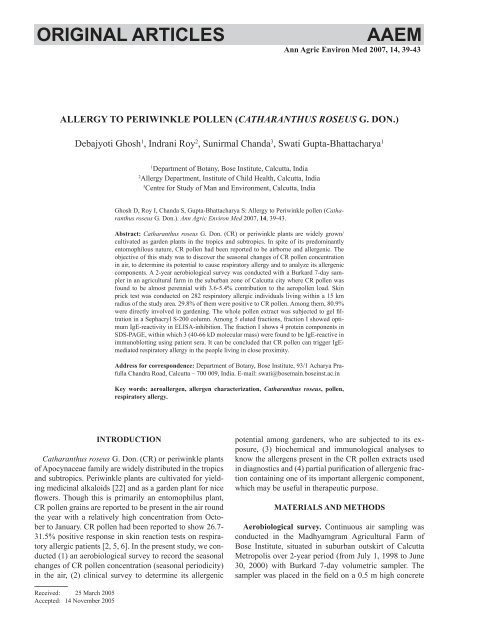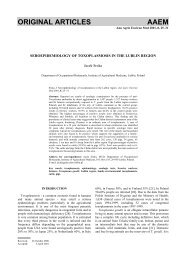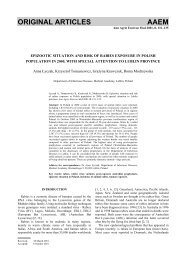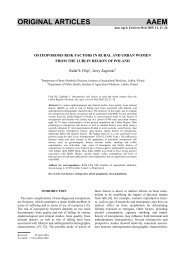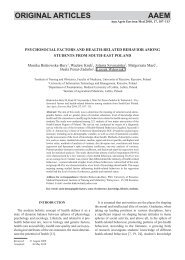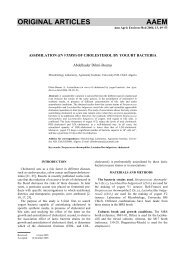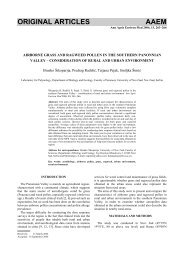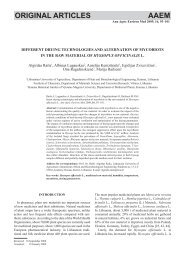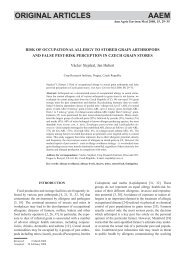ALLERGY TO PERIWINKLE POLLEN (CATHARANTHUS ROSEUS ...
ALLERGY TO PERIWINKLE POLLEN (CATHARANTHUS ROSEUS ...
ALLERGY TO PERIWINKLE POLLEN (CATHARANTHUS ROSEUS ...
You also want an ePaper? Increase the reach of your titles
YUMPU automatically turns print PDFs into web optimized ePapers that Google loves.
ORIGINAL ARTICLES<br />
AAEM<br />
Ann Agric Environ Med 2007, 14, 39-43<br />
<strong>ALLERGY</strong> <strong>TO</strong> <strong>PERIWINKLE</strong> <strong>POLLEN</strong> (<strong>CATHARANTHUS</strong> <strong>ROSEUS</strong> G. DON.)<br />
Debajyoti Ghosh 1 , Indrani Roy 2 , Sunirmal Chanda 3 , Swati Gupta-Bhattacharya 1<br />
1<br />
Department of Botany, Bose Institute, Calcutta, India<br />
2<br />
Allergy Department, Institute of Child Health, Calcutta, India<br />
3<br />
Centre for Study of Man and Environment, Calcutta, India<br />
Ghosh D, Roy I, Chanda S, Gupta-Bhattacharya S: Allergy to Periwinkle pollen (Catharanthus<br />
roseus G. Don.). Ann Agric Environ Med 2007, 14, 39-43.<br />
Abstract: Catharanthus roseus G. Don. (CR) or periwinkle plants are widely grown/<br />
cultivated as garden plants in the tropics and subtropics. In spite of its predominantly<br />
entomophilous nature, CR pollen had been reported to be airborne and allergenic. The<br />
objective of this study was to discover the seasonal changes of CR pollen concentration<br />
in air, to determine its potential to cause respiratory allergy and to analyze its allergenic<br />
components. A 2-year aerobiological survey was conducted with a Burkard 7-day sampler<br />
in an agricultural farm in the suburban zone of Calcutta city where CR pollen was<br />
found to be almost perennial with 3.6-5.4% contribution to the aeropollen load. Skin<br />
prick test was conducted on 282 respiratory allergic individuals living within a 15 km<br />
radius of the study area. 29.8% of them were positive to CR pollen. Among them, 80.9%<br />
were directly involved in gardening. The whole pollen extract was subjected to gel filtration<br />
in a Sephacryl S-200 column. Among 5 eluted fractions, fraction I showed optimum<br />
IgE-reactivity in ELISA-inhibition. The fraction I shows 4 protein components in<br />
SDS-PAGE, within which 3 (40-66 kD molecular mass) were found to be IgE-reactive in<br />
immunoblotting using patient sera. It can be concluded that CR pollen can trigger IgEmediated<br />
respiratory allergy in the people living in close proximity.<br />
Address for correspondence: Department of Botany, Bose Institute, 93/1 Acharya Prafulla<br />
Chandra Road, Calcutta – 700 009, India. E-mail: swati@bosemain.boseinst.ac.in<br />
Key words: aeroallergen, allergen characterization, Catharanthus roseus, pollen,<br />
respiratory allergy.<br />
INTRODUCTION<br />
Catharanthus roseus G. Don. (CR) or periwinkle plants<br />
of Apocynaceae family are widely distributed in the tropics<br />
and subtropics. Periwinkle plants are cultivated for yielding<br />
medicinal alkaloids [22] and as a garden plant for nice<br />
flowers. Though this is primarily an entomophilus plant,<br />
CR pollen grains are reported to be present in the air round<br />
the year with a relatively high concentration from October<br />
to January. CR pollen had been reported to show 26.7-<br />
31.5% positive response in skin reaction tests on respiratory<br />
allergic patients [2, 5, 6]. In the present study, we conducted<br />
(1) an aerobiological survey to record the seasonal<br />
changes of CR pollen concentration (seasonal periodicity)<br />
in the air, (2) clinical survey to determine its allergenic<br />
potential among gardeners, who are subjected to its exposure,<br />
(3) biochemical and immunological analyses to<br />
know the allergens present in the CR pollen extracts used<br />
in diagnostics and (4) partial purification of allergenic fraction<br />
containing one of its important allergenic component,<br />
which may be useful in therapeutic purpose.<br />
MATERIALS AND METHODS<br />
Aerobiological survey. Continuous air sampling was<br />
conducted in the Madhyamgram Agricultural Farm of<br />
Bose Institute, situated in suburban outskirt of Calcutta<br />
Metropolis over 2-year period (from July 1, 1998 to June<br />
30, 2000) with Burkard 7-day volumetric sampler. The<br />
sampler was placed in the field on a 0.5 m high concrete<br />
Received: 25 March 2005<br />
Accepted: 14 November 2005
40 Ghosh D, Roy I, Chanda S, Gupta-Bhattacharya S<br />
base. The exposed slides were mounted and trapped pollen<br />
grains were microscopically counted following guidelines<br />
of the British Aerobiology Federation [33] to study the periodicity<br />
patterns.<br />
Source materials. Fresh pollen samples were collected<br />
from the flowering plants. The batch used for the entire<br />
study contained not more than 5% non-pollen impurities<br />
(in term of the number of counted particles).<br />
Extract Preparation. Pollen samples were defatted<br />
with diethyl ether and extracted in phosphate buffered saline<br />
(PBS, 0.1 M Na-phosphate containing 0.15 M NaCl,<br />
pH 7.2) by continuous stirring at 4°C for 16h in 1:50 w/v<br />
ratio. After centrifugation at 12,500 g for 40 min, the clear<br />
supernatant was dialyzed and passed through a 0.22 μm<br />
Millipore filter (Millipore Corp., Bedford, USA). The filtrate<br />
was then lyophilized and stored at -70°C in aliquots<br />
of known volume in sterile vials. The protein content of<br />
whole extract and fractions were determined following<br />
Lowry’s method [20].<br />
Study group. 282 respiratory allergic patients were<br />
recruited in the patient group when attending the allergy<br />
clinic in the Institute of Child Health, Calcutta during<br />
2000-2003. 112 (39.7%) of them had allergic rhinitis, 80<br />
(28.4%) had bronchial asthma and 90 (31.91%) had the<br />
combination of both allergic rhinitis and bronchial asthma<br />
as per physicians’ diagnosis. The age range of this group<br />
was 19-64 years (mean age 32.28 ± 2.1 years). The gender<br />
ratio of this group was male/female = 110/172 = 0.64. The<br />
patients with severe perennial asthma, pregnancy/lactation,<br />
malignancy and other systemic diseases were excluded. 76<br />
non-sensitized volunteers (confirmed by negative skin reaction<br />
and IgE-ELISA) having no history of previous or<br />
current episode of any allergic, systemic or joint diseases in<br />
themselves/their families were recruited in control group.<br />
The subjects were selected from the suburban area who<br />
were residing within 15 km distance of the study field.<br />
The demographic data of study group (patient and control<br />
group) has been described in Table 1. The recruitment of<br />
study group was approved by the Ethics Committee of the<br />
hospital.<br />
Skin prick tests (SPT) and sera collection. Skin prick<br />
tests were carried out with CR pollen extracts (1:50 w/v)<br />
on 282 adult subjects with case history of allergic rhinitis<br />
or mild intermittent allergic asthma. All of them were reporting<br />
CR plants growing in their surroundings when attending<br />
the Allergy Clinic of the Institute of Child Health,<br />
Calcutta, during 2000-2003. The exclusion criteria were<br />
perennial or severe asthma, pregnancy or lactation, malignancy<br />
or other severe systemic diseases during skin testing<br />
or sera collection. To avoid masking of possible symptoms,<br />
corticosteroids and antihistamines were prohibited. The study<br />
was approved by the Ethics Committee of the hospital.<br />
Table 1. Characteristics of respiratory allergic patients and control subjects<br />
selected for study.<br />
Patient group:<br />
Total no. (n) = 282 Male/Female = 110/172 = 0.64<br />
Age (Years):<br />
Range = 19-64 Mean Age (X ± SD) = 32.3 ± 2.10<br />
Symptomatic diagnoses<br />
Allergic rhinitis: n = 112 (39.7%)<br />
Allergic asthma: n = 80 (28.4%)<br />
Combination of allergic rhinitis and asthma: n = 90 (31.9%)<br />
Positive in skin reaction:<br />
Total no. = 84 (29.78%) Male/Female = 38/46 = 0.83<br />
Direct involvement in gardening (n) = 68 (80.9%)<br />
No. of patients with +2/more level of reaction (n) = 6 (7.1%)<br />
Control group<br />
Total no. = 76 Male/Female = 30/46 = 0.65<br />
Age (Years):<br />
Range = 23-69 Mean Age (X ± SD) = 33.5 ± 1.80<br />
Histamine diphosphate (10 mg/ml) and PBS were used as<br />
positive and negative controls respectively. The reaction<br />
measurement was performed after 20 minutes. According<br />
to international guidelines, positivity was defined as mean<br />
wheal diameter ≥3mm, larger than compared with negative<br />
control [9]. The reaction was graded from +1 to +3 level<br />
(+1 = erythema, 20 mm in diameter, +2 = erythema >20<br />
mm in diameter, +3 = wheal and erythema) according to<br />
Stytis et al. [32]. Control sera were collected from nonsensitized<br />
healthy volunteers (confirmed by negative skin<br />
reaction and IgE-ELISA) having no history of previous or<br />
current episode of any allergic, systemic or joint diseases<br />
in them and their families.<br />
Polyacrylamide gel electrophoresis with sodium dodecyl<br />
sulfate (SDS-PAGE). SDS-PAGE analysis of whole<br />
pollen extract and fractions were performed according to<br />
Laemmli [19]. The isolated allergenic fraction of CR pollen<br />
was studied in native (untreated) condition according<br />
to Hames [17].<br />
Fractionation of CR pollen allergen. The total protein<br />
of whole pollen extract was precipitated by 0-90% saturation<br />
of (NH 4<br />
) 2<br />
SO 4<br />
. The precipitation was dissolved in PBS<br />
and dialyzed (mol. cut-off limit 10,000) to remove traces of<br />
ammonia and stored at -70°C. The concentrated protein (6<br />
mg/ml) solution was subjected to Sephacryl S-200 column<br />
(d = 2.4 cm, h = 55.5 cm) equilibrated with 10 mM PBS,<br />
pH 7.2 for gel filtration. The fractions were collected in 3<br />
ml aliquots (void volume 83 ml, flow rate 12 ml/h) at 4°C<br />
and the elution was monitored at 280 nm using a spectrophotometer.<br />
Enzyme linked immunosorbent assay (ELISA) and<br />
ELISA inhibition. ELISA was performed to determine CR<br />
pollen specific IgE levels in individual patient sera using<br />
anti-human IgE horseradish peroxidase conjugate (Sigma)<br />
in 1: 1200 dilution and o-phenylene diamine substrate [10].
Periwinkle pollen allergy 41<br />
0.6<br />
0.5<br />
200 KD 150 kD 66 kD 29 kD 12.4 kD<br />
↓ ↓ ↓ ↓ ↓<br />
Fr. I<br />
Optical density at 280 nm<br />
0.4<br />
0.3<br />
0.2<br />
Fr. II<br />
Fr. III<br />
Fr. IV<br />
Fr. V<br />
0.1<br />
Figure 1. Scanning electron micrograph of Catharanthus roseus pollen<br />
(×500).<br />
The absorbance was measured with an ELISA reader at<br />
492 nm. The individual serum having P/N value (ratio of<br />
optical density of patient sera with respect to control) > 3.0<br />
were used for immunoblotting [4]. In immunoblotting the<br />
control value was the mean derived from the panel of 12<br />
normal (selected from control group) sera. ELISA inhibition<br />
was performed by overnight pre-incubation of patient<br />
sera with equal volume of (a) whole extract (100 μg protein/ml)<br />
and (b) fractions of CR pollen extract with varying<br />
protein concentrations at 4°C. The inhibited serum was<br />
then used in ELISA with anti-IgE horseradish peroxidase<br />
conjugate. Percentage inhibition was calculated as:<br />
% Inhibition = O.D. of test sample - O.D. of inhibited sample × 100 O.D. of test sample<br />
The 0% inhibition was obtained by incubating serum<br />
samples with PBS. A dose-response curve was obtained by<br />
plotting the percentage of inhibition against the log of protein<br />
concentrations.<br />
IgE specific immunoblotting. IgE-immunoblotting was<br />
performed onto PVDF membrane according to Sambrook<br />
et al. [24] for whole pollen extract and isolated fractions.<br />
Serum was diluted in 1:5 (v/v) ratio in PBS. The IgE-reactive<br />
bands were detected with anti human IgE (Sigma)<br />
coupled with horseradish peroxidase enzyme (1:500 v/v<br />
dilution and diaminobenzidine as substrate.<br />
0<br />
0 10 20 30 40 50 60 70<br />
Tube No.<br />
Figure 3. Gel filtration of whole extract of Catharanthus roseus pollen in<br />
Sephacryl S-200 column.<br />
RESULTS<br />
Aerobiological study. In the volumetric air sampling of<br />
the agricultural farm, CR pollen (Fig. 1) was found to be<br />
almost perennial (except in July of both 1998 and 1999).<br />
This pollen concentration showed the peak in March, when<br />
it contributed 5.4% (1999) and 3.6% (2000) of total aeropollen<br />
load respectively (Fig. 2).<br />
Clinical study. We selected 282 adult patients (M/F =<br />
110/172, Mean age 32.3 ± 2.1 years, FEV 1<br />
< 80%) with<br />
allergic rhinitis, allergic asthma and combination of both<br />
(Tab. 1) for skin reaction study. 84 (29.8%) of the study<br />
population showed positive skin reaction towards CR pollen<br />
extract in SPT. Among the positive subjects, 6 (7.1%)<br />
showed +2/more level of reaction. 68 (80.9%) of the susceptible<br />
patients were found to be directly involved in gardening<br />
and reported CR plant exposure.<br />
Fractionation of CR pollen extract. The whole protein<br />
extract of CR pollen gave rise of five fractions (Fr. I – Fr.<br />
V) corresponding to five peaks in Sephacryl S-200 column<br />
(Fig. 3).<br />
Average pollen count/d/m 3 (Catharanthus)<br />
25<br />
20<br />
15<br />
10<br />
5<br />
0<br />
Catharanthus (1998-1999)<br />
Catharanthus (1999-2000)<br />
Total pollen (1998-1999)<br />
Total pollen (1999-2000)<br />
Jul Aug Sep Oct Nov Dec Jan Feb Mar Apr May Jun<br />
1600<br />
1400<br />
1200<br />
1000<br />
800<br />
600<br />
400<br />
200<br />
0<br />
Average pollen count/d/m 3 (total polen)<br />
IgE-ELISA inhibition (%)<br />
100<br />
90<br />
80<br />
70<br />
60<br />
50<br />
40<br />
30<br />
20<br />
10<br />
0<br />
Crude extract<br />
Fr. I<br />
Fr. II<br />
Fr. III<br />
Fr. IV<br />
Fr. V<br />
μg protein/ml<br />
1.00E-03 0.01 0.1 1 10 100<br />
Figure 2. Seasonal mean periodicity of airborne Catharanthus roseus<br />
pollen (1998-2000) with respect to total airborne pollen load.<br />
Figure 4. IgE-ELISA inhibition with pooled patient sera using different<br />
fractions of Catharanthus roseus pollen in comparison with crude extract.
42 Ghosh D, Roy I, Chanda S, Gupta-Bhattacharya S<br />
97<br />
66<br />
55<br />
31<br />
21<br />
14<br />
M C F B<br />
Figure 5. The whole extract (C) & Fraction I (F) of Catharanthus roseus<br />
pollen and IgE-immunoblot of Fraction I (B) using PVDF membrane, M ><br />
Molecular weight marker.<br />
IgE ELISA inhibition. The allergenic potential of each<br />
fraction was then studied by IgE ELISA inhibition with<br />
pooled sera of seven patients [with P/N value (the ratio of<br />
o.d. of patients with normal/control serum) > 3.5 in IgE<br />
ELISA]. The Fr. I showed 50% inhibition with < 0.1 μg<br />
of protein (Fig. 4), whereas Fr. IV attained 50% inhibition<br />
with 0.1 μg of protein. Fractions II and III failed to reach<br />
that value within the concentration range studied.<br />
SDS-PAGE and immunoblotting. In the 11% SDS-<br />
PAGE, whole extract of CR pollen showed 20-25 protein<br />
components within the molecular weight range of 14 to 66<br />
kD (Fig. 5). The Fr. I showed the presence of four protein<br />
components. In immunoblotting with pooled CR sensitive<br />
patient sera, three bands of 47, 58 and 66 kD molecular<br />
mass were found to be IgE reactive.<br />
DISCUSSION<br />
Airborne pollen grains are the earliest known allergen<br />
to cause human respiratory allergy. Generally it was considered<br />
that the entomophilous plants are allergy-safe as<br />
their pollen grains have less chance to be dispersed in air<br />
in larger quantities. In spite of that, there are a number of<br />
aeropalynological studies [1, 5, 21, 34] from different parts<br />
of India in which entomophilous pollen grains had been<br />
reported to be airborne. A number of important allergenic<br />
pollen types, e.g., the pollen grains of Cassia sp.[26], Anacardium<br />
occidentale (cashew) [12], Brassica campestris<br />
[29], Brasica napus (oilseed rape) [13], Helianthus annus<br />
(sunflower) [18], Ligustrum sp. (privet) [3], Olea europea<br />
(olive) [14], etc., are primarily entomophilous.<br />
In the present study the two-year continuous aerobiological<br />
survey in an agricultural farm showed a consistent<br />
presence of Catharanthus pollen in the air. After recruitment<br />
of patient group residing in the suburban zone near<br />
sampling site, it was found that all of them resided within<br />
15 km distance from the site. The selected respiratory allergic<br />
patients had a fair chance of exposure to CR pollen.<br />
Among the sensitive (29.8%) patients, 80.9% were<br />
involved in gardening and could have possible exposure to<br />
airborne CR pollen. There are a number of reports describing<br />
cases of occupational allergy by flowers [8, 11, 15].<br />
Studies on work-related allergic symptoms had revealed<br />
prevalence of sensitization to relevant pollen for Chrysanthemum<br />
[15] and bell pepper [16]. In this respect, CR pollen<br />
clearly showed a putative role of this pollen as causal<br />
agent of occupational respiratory allergy among gardeners<br />
of the study area. In the next step, a detail case study on the<br />
CR sensitized gardeners is required to confirm their disorder<br />
as occupational disease.<br />
In addition, environmental factors are often reported to<br />
play a role to make a pollen allergenic. Interaction with<br />
atmospheric dust [23], microbial flora [30], gaseous pollutants<br />
[25] and bacterial endotoxin [31] evidently strengthen<br />
the allergenic potential of airborne pollen grains.<br />
In the immunochemical analyses the Fr. I of CR pollen<br />
whole extract had been found to contain three IgE- reactive<br />
components of 47, 48 & 66 kD molecular weight. The<br />
role of characterized allergens are very important in the<br />
diagnoses and therapy of allergic disorders [7, 28]. This<br />
partially purified allergenic fraction may be useful [28] in<br />
therapeutic purposes in sensitive patients after detail and in<br />
depth analyses.<br />
Hence, in this study, it is evident that the CR pollen is<br />
airborne. In spite of its entomophilous nature, CR pollen<br />
contributes 3.6-5.4% of total aeropollen load of the study<br />
area. In the clinical survey, CR pollen showed 29.8% positive<br />
skin reaction among the population of 282 respiratory<br />
allergic patients, most of which are involved in gardening.<br />
In immunochemical analyses a number of allergenic protein<br />
fractions had been detected from the whole protein extract<br />
of CR pollen and partial purification of its major allergenic<br />
fraction Fr.I will be helpful in allergy diagnostics and<br />
therapy of patients susceptible to CR pollen. Finally, CR<br />
pollen can be listed as an important occupational aeroallergen<br />
(where people are involved in gardening) from India.<br />
REFERENCES<br />
1. Agashe SN: Airborne entomophilous pollen – potential source of<br />
allergy. In: Tilak ST (Eds.): Recent Researches in Ecology: Environment<br />
and Pollution, 153-157. Today and Tomorrows Printers & Publishers,<br />
New Delhi 1989.<br />
2. Banik S, Chanda S: Airborne pollen survey of central Calcutta,<br />
India, in relation to allergy. Grana 1992, 31, 72-75.<br />
3. Carinanos P, Alcazar P, Galan C, Dominguez E: Privet pollen (Ligustrum<br />
sp.) as potential cause of pollinosis in the city of Cordoba, southwest<br />
Spain. Allergy 2002, 57, 92-97.<br />
4. Chakraborty P, Chowdhury I, Gupta-Bhattacharya S, Gupta S,<br />
Sengupta DN, Chanda S: Clinico-immunologic studies on Phoenix sylvestris<br />
Roxb. pollen: An aeroallergen from Calcutta, India. Allergy 1999, 54, 85-89.<br />
5. Chakraborty P, Gupta Bhattacharya S, Chakraborty C, Lacey J,<br />
Chanda S: Airborne allergenic pollen grains on a farm in West Bengal,<br />
India. Grana 1998, 37, 53-57.
Periwinkle pollen allergy 43<br />
6. Chakraborty P, Gupta-Bhattacharya S, Chanda S: Biochemical<br />
and clinical investigations on a few common airborne pollen grains from<br />
West Bengal, India. J Palynol (India) 1995, 31, 213-220.<br />
7. Chanda S: Implications of aerobiology in respiratory allergy. Ann<br />
Agric Environ Med 1996, 3(2), 157-164.<br />
8. de Jong NW, Vermeulen AM, van Gerth Wijk R, de Groot H: Occupational<br />
allergy caused by flowers. Allergy 1998, 53(2), 204-209.<br />
9. Dreborg S, Frew AJ (Eds): Allergen standardization and skin tests.<br />
Allergy 1993, 48(Suppl 14), 49-82.<br />
10. Engvall E, Perlman P: Enzyme linked immunosorbent assay (ELI-<br />
SA): quantitative assay for immunoglobulin G. Immunochemistry 1971,<br />
8, 871-879.<br />
11. Estlander T, Kanerva L, Tupasela O, Jolanki R: Occupational contact<br />
urticaria and type I sensitization caused by gerbera. Contact Dermatitis<br />
1998, 38(2), 118-120.<br />
12. Fernandes L, MesquiteaAM: Anacardium occidentale (cashew)<br />
pollen allergy in patients with allergic bronchial asthma. J Allergy Clin<br />
Immunol 1995, 95, 501-504.<br />
13. Focke M, Hemmer W, Gotz M, Jarisch R: Identification of allergens<br />
in oilseed rape (Brassica napus) pollen. Int Arch Allergy Immunol<br />
1998, 117, 105-112.<br />
14. Gonzalez Minero FJ, Candau P: Olea europaea airborne pollen in<br />
southern Spain. Ann Allergy Asthma Immunol 1997, 78, 278-284.<br />
15. Groenewoud GC, de Jong NW, Burdorf A, de Groot H, van Wijk<br />
RG: Prevalence of occupational allergy to Chrysanthemum pollen in<br />
greenhouses in the Netherlands. Allergy 2002, 57(9), 835-840.<br />
16. Groenewoud GC, de Jong NW, van Oorschot-van Nes AJ, Vermeulen<br />
AM, van Toorenenbergen AW, Mulder PG, Burdorf A, de Groot<br />
H, van Wijk RG: Prevalence of occupational allergy to bell pepper pollen<br />
in greenhouses in the Netherlands. Clin Exp Allergy 2002, 32(3), 434-440.<br />
17. Hames BD: One dimensional gel electrophoresis. In: Hames<br />
BD, Rickwood D (Eds.): Gel Electrophoresis of Protein: A Practical Approach,<br />
37. 2nd ed. IRL Press, Oxford 1996.<br />
18. Jimenez A, Moreno C, Martinez J, Martinez A, Bartolome B,<br />
Guerra F, Palacios R: Sensitization to sunflower pollen: only an occupational<br />
allergy? Int Arch Allergy Immunol 1994, 105, 297-305.<br />
19. Laemmli UK: Cleavage of structural protein during assembly of<br />
the head of the bacteriophage T4. Nature 1970, 227, 680-684.<br />
20. Lowry OH, Rosenbrough MJ, Farr HL, Randall RI: Protein measurement<br />
with folin phenol reagent. J Biol Chem 1951, 193, 256-275.<br />
21. Mandal S, Chanda S: Aeroallergens of West Bengal in the context<br />
of environmental pollution and respiratory allergy. Biol Mem 1981, 6, 1-61.<br />
22. Noble RL: The discovery of the vinca alkaloids-chemotherapeutic<br />
agents against cancer. Biochem Cell Biol 1990, 68, 1344-1351.<br />
23. Obtułowicz K, Kotlinowska T, Stobiecki M, Dechnik K, Obtułowicz<br />
A, Manecki A, Marszałek M, Schejbal-Chwastek M: Environmental air<br />
pollution and pollen allergy. Ann Agric Environ Med 1996, 3(2), 131-138.<br />
24. Sambrook J, Fritsh EF, Maniatis T: Molecular Cloning. A Laboratory<br />
Manual. 2nd ed. Cold Spring Harbor Laboratory Press, New York 1989.<br />
25. Santra SC, Gupta S, Chanda S: Air pollutants and aeroallergen<br />
interaction. Grana 1991, 30, 63-66.<br />
26. Satheesh R, Prakashkumar R, Jose JD, Nair PK, Rao GR: Studies<br />
on Cassia pollen grains of India. Int Arch Allergy Immunol 1994, 103,<br />
280-285.<br />
27. Singh AB, Dahiya P: Antigenic and allergenic properties of Amaranthus<br />
spinosus pollen – a commonly growing weed in India. Ann Agric<br />
Environ Med 2002, 9(2), 147-151.<br />
28. Singh AB, Kumar P: Aeroallergens in clinical practice of allergy<br />
in India. An overview. Ann Agric Environ Med 2003, 10(2), 131-136.<br />
29. Singh BP, Verma J, Rai D, Sridhara S, Gaur SN, Gangal SV: Immunochemical<br />
characterization of Brassica campestris pollen allergen.<br />
Int Arch Allergy Immunol 1995, 108, 43-48.<br />
30. Śpiewak R, Krysińska-Traczyk E, Sitkowska J, Dutkiewicz J: Microflora<br />
of allergenic pollens – a preliminary study. Ann Agric Environ<br />
Med 1996, 3(2), 127-130.<br />
31. Śpiewak R, Skórska C, Prażmo Z, Dutkiewicz J: Bacterial endotoxin<br />
associated with pollen as a potential factor aggravating pollinosis.<br />
Ann Agric Environ Med 1996, 3(1), 57-59.<br />
32. Stytis DP, Stobo JD, Fudenberg H, Wells JV: Basic and Clinical<br />
Immunology. 4th ed. Lange Medical Publ., Maruzen Asia Pvt. Ltd., Singapore,<br />
1982.<br />
33. The British Aerobiology Federation: A Guide to Trapping and<br />
Counting. Kimberley Clark Ltd., UK, 1995.<br />
34. Tilak ST: Airborne entomophilous pollen. J Plant Nat 1984, 1,<br />
45-50.


